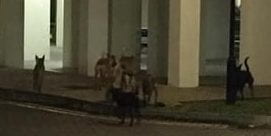Hi everyone! Previously I shared my observations of Free-ranging domestic dog (FRDDs) packs. Not only are the pack gaining more dog members, I realised that the FRDD packs are venturing into residential areas more frequently as well. These occurrences started happening after the establishment of new residential flats in Tampines.

This photo was from 7 November 2018, which coincides with the construction period of Build-To-Order flats in Tampines. I wonder if this observation has got to do with the increasing land use for residential areas. If so, are they venturing to new territories they have yet to explore?
Indeed, there were reports by some park visitors of the stray dog packs in Tampines nature parks under the National Parks Board. I suspect there would be an increased probability of dog-wildlife conflict in the parks, considering there are stray dog-cat conflicts. 
“Fatal attack of a cat by stray dogs” Photo by Rachel Ong
My suspicion is confirmed by the predation on primates by FRDDs in Bukit Timah Reserve (Riley et al., 2015). It was observed that a pack of 3FRDDs killed a juvenile Long-tailed macaque (Macaca fascicularis). Though Singapore’s Animal Veterinary Authority has culled 360 macaques in 2013 in response to 920 complaints from residents living near the reserve borders or park visitors, of “monkey nuisance”. The Macaca fascicularis is considered “Vulnerable” under the IUCN Red List, meaning they face high extinction risk in the wild.
The unfortunate attack happened on a man-made bicycle path within the reserve. Well, being on an anthropogenic landscape has decreased the macaque’s probability of survival since it was not on a tree where the dogs cannot reach, nor did it had time to respond and climb onto trees. Hence, one seemingly harmless man-made path raised the susceptibility of the prey to FRDD attacks. This occurrence reflects my sentiment on how anthropogenic factors are tied to the increasing impacts of FRDDs.
I wondered if humans have unknowingly paved the way for FRDDs in becoming effective predators of wildlife species, with our modifications to the environment? Let us investigate if Australia has magnified impacts of FRDD due to human-modified environments.
The study by Taylor et al. (2018) addresses how the environmental impacts by FRDD could potentially be amplified by urbanisation. The data collected from Australia Zoo Wildlife Hospital and Wildlife Rehabilitation Centre showed that dog attacks were the second most common reason for wildlife to be admitted for medical treatment, with car strikes being the first. It was highlighted that Koala bears (Phascolarctos cinereus), classified as vulnerable under IUCN Red List, were attacked by FRDDs in urbanised areas at bridges and telegraph poles. This signifies how human-modified environments not only cause habitat loss and habitat fragmentation, but it could also facilitate hunting of wildlife by dogs as well.
This highlights the need for wildlife conservation methods to be reconsidered in the process of urban expansion, with the FRDDs in mind.
I’ll side-track here: Do you think the culling of Macaques by Singapore is appropriate or just a knee-jerk reaction to complaints? The vulnerability of the Macaca fascicularis species reflects the intra-specific taxa assessment of the subspecies Macaca fascicularis ssp. philippensis in Philippines, threatened by sport hunting, research purposes and consumption by humans. On the other hand, the macaque is considered invasive under the Global Invasive Species Database (GISD), managed by IUCN, due to their impacts on native biodiversity. Isn’t Singapore doing biodiversity a favour? I’ll discuss more about environmental ethics in decision making related to FRDD in my next post!
References:
Eudey, A., Kumar, A., Singh, M. & Boonratana, R. 2020. Macaca fascicularis. The IUCN Red List of Threatened Species 2020: e.T12551A17949449. https://dx.doi.org/10.2305/IUCN.UK.2020-2.RLTS.T12551A17949449.en. Downloaded on 30 October 2020.
Riley Koenig, Crystal & Koenig, Bryan & Gumert, Michael. (2015). Observation of a fatal dog attack on a juvenile long-tailed macaque in a human-modified environment in Singapore. Nature in Singapore. 8. 57-63.
Taylor-Brown A, Booth R, Gillett A, Mealy E, Ogbourne SM, et al. (2019) The impact of human activities on Australian wildlife. PLOS ONE 14(1): e0206958. https://doi.org/10.1371/journal.pone.0206958
Woinarski, J. & Burbidge, A.A. 2020. Phascolarctos cinereus (amended version of 2016 assessment). The IUCN Red List of Threatened Species 2020: e.T16892A166496779. https://dx.doi.org/10.2305/IUCN.UK.2020-1.RLTS.T16892A166496779.en. Downloaded on 30 October 2020.